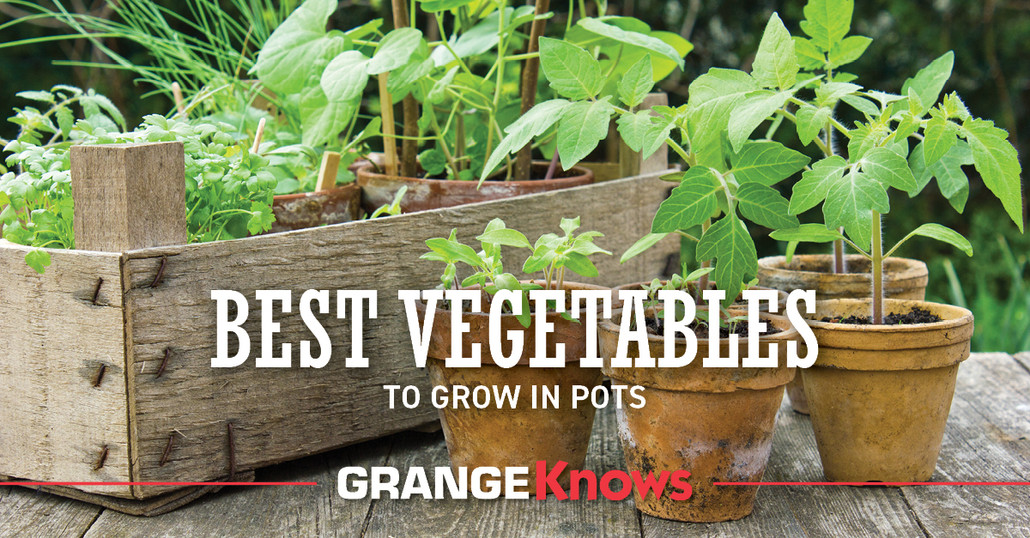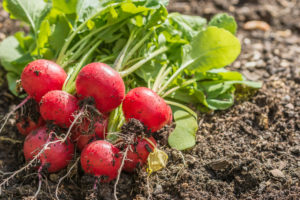
Best Vegetables to Grow in Pots
Posted by Grange Co-op on 19th Jul 2021
In this article, we will discuss the best vegetables you can grow even if you don’t have a garden plot. Limited on space? We're highlighting some of our favorite vegetables for container gardening located on balconies, porches, or patios with available sunlight.
1. Tomatoes (Solanum Lycopersicum)
Tomatoes are undoubtedly one of the most productive vegetables for container gardening, providing almost 10 pounds to harvest per plant every season.

The minimum pot depth needed to grow tomatoes is around 12 inches. Plus, they need plenty of sunlight (at least five to six hours). Sunny roof terraces are ideal for them. Keep in mind as tomatoes develop and the fruits ripen, they do not require frequent watering. The best practice to encourage deep root establishment consists of heavy watering, less frequently.
2. Spinach (Spinacia oleracea)
Spinach is one of the best vegetables for container gardening and growing it is incredibly simple.
When growing spinach, you will need a container around 6 to 8 inches deep. Spinach thrives in partial shade and any type of space. You can choose to grow it indoors, on a windowsill, or any other place that doesn’t get direct sunlight. Spinach thrives in cooler temperatures and will bolt if left outside and temperatures are consistently hot and dry.
Because it grows so abundantly in cooler temperatures, spinach can be grown during the winter months. However, you will have to water them properly to ensure that they don’t dry out from the indoor heat.
3. Beans (Phaseolus vulgaris)
Owing to their stunning foliage and flowers, green beans are an excellent addition to any courtyard or balcony. For best results, make sure you have a container with a minimum depth of 12 inches.
You can grow beans in containers in two different ways. Your first option is to go with a bush variety of beans that will thrive in a container without any additional support.
Alternatively, you can choose to grow a climbing variety. For this, you will need a pole or trellis of some kind to let the bean travel up once it starts to develop and grow larger. Not only will it help you make the most of your vertical space, but it’ll also make it easy to pick off the beans once they’re ready for harvest.
4. Lettuce (Lactuca sativa)
Growing lettuce in pots is easy and fast. Following the instructions on the seed packets, simply sow your lettuce seeds directly into potting soil within a container that has a depth of at least 6 inches. Feel free to plant lettuce with other greens, including arugula, spinach or cilantro.
Container gardening gives you the flexibility to control weeds and pests easier than in-ground planting. Most varieties of lettuces and salad greens are perfect for spring. However, there are newer varieties designed to resist the summer heat.
Similar to spinach, lettuce doesn’t require as much sunlight as other vegetables. Thus, you can even extend your harvest by moving your pot to a cooler, shady area as the growing season gets hotter.
5. Peppers (Capsicum annuum)
Both sweet and hot peppers can be strikingly beautiful, and available in a variety of purple and orange sweet peppers, making them perfect for planting in pots.

Picking the right container size is extremely important. Make sure the peppers have adequate room to grow, avoid crowding. Larger peppers will need a 5 – 10 gallon pot whereas smaller varieties will need at least a 2-gallon container. Along with that, you need to make sure that the peppers receive a minimum of 8 hours of sunlight every day.
6. Kale (Brassica oleracea)
Another space-saving vegetable ideal for container gardening is the nutrient-rich kale. Add it in salads, smoothies, sandwiches, or soup to enhance the food's taste and nutritional value.
You can grow nearly six kale plants in a container that is approximately 20 inches wide. The best thing about growing kale in pots is the ease of transporting them. You can move them indoors in the summer months, or in the shade during the cold winter months. Kale is quite simple to grow, making a fresh supply throughout the year attainable.
When growing kale, make sure you don’t overwater. Equally as important, don’t allow them to dry out completely either, and keep them in a place that receives a limited amount of indirect sunlight each day.
7. Peas (Pisum sativum)
Peas thrive in moderate conditions and don't require a large container to grow them. They are low maintenance, requiring little attention and are ideal for growing on balconies.
Peas are also ideal for succession planting as they enrich the soil with nitrogen. Meaning, once you have harvested peas, you can pluck them out and plant something else in that pot!
You can plant peas in early spring and then again when temperatures beginning cooling off in the fall. If you choose bush or dwarf pea varieties, you will need to water them frequently and regularly, as peas thrive in slightly moist soil. Also make sure to keep your plant in a place that receives direct sunlight.

8. Radishes (Raphanus sativus)
Radishes can thrive in pots that are just 4 – 6 inches deep. Scatter the seeds in a container and water them regularly to let them grow into a healthy radish plant. Radishes have extremely quick harvest times and don’t need much time to grow. In fact, most are ready for harvest in thirty days since the time of planting.
Note that radishes can wilt in high temperatures, but you can easily control this by keeping the plant in a shady area or by watering them regularly to keep their temperature low. There are plenty of varieties of radishes, which means you can choose your seeds based on flavor and appearance.
Now that you know which vegetables can be grown in pots, you can easily get started with container gardening. At Grange Co-op, we have a range of seeds, fertilizers, and other gardening equipment that will help you get the best results! For more information visit us in-store and speak with Grange Gardening Expert or online for additional information and supplies needed for successful gardening.
